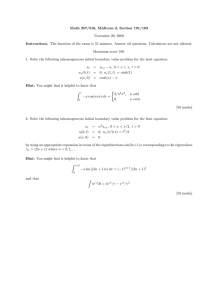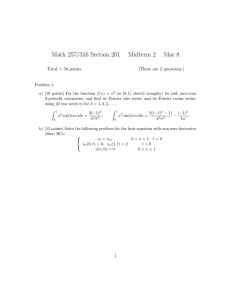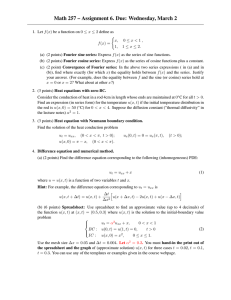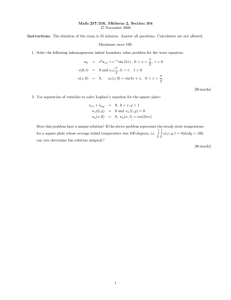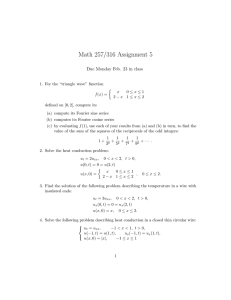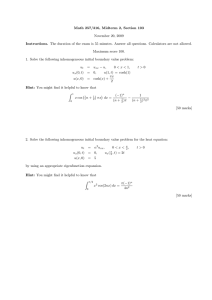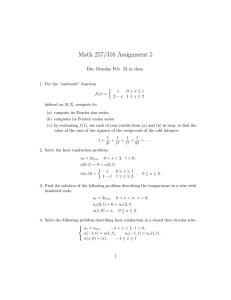Document 13570446
advertisement
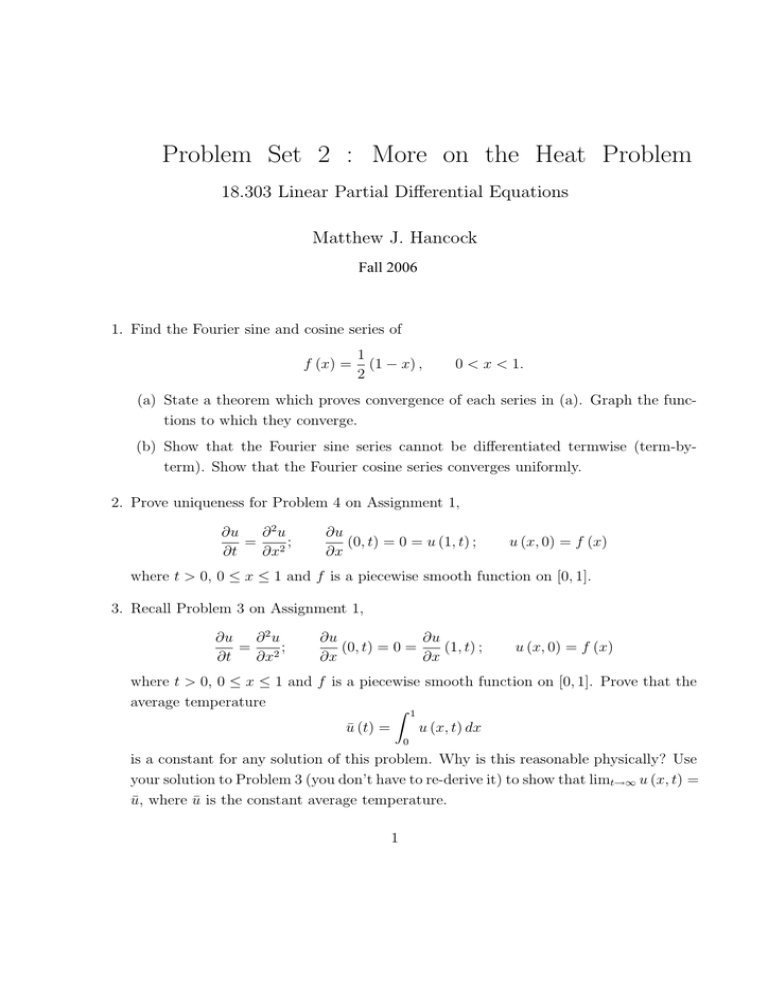
Problem Set 2 : More on the Heat Problem 18.303 Linear Partial Differential Equations Matthew J. Hancock Fall 2006 1. Find the Fourier sine and cosine series of f (x) = 1 (1 − x) , 2 0 < x < 1. (a) State a theorem which proves convergence of each series in (a). Graph the functions to which they converge. (b) Show that the Fourier sine series cannot be differentiated termwise (term-byterm). Show that the Fourier cosine series converges uniformly. 2. Prove uniqueness for Problem 4 on Assignment 1, ∂u ∂ 2u = ; ∂t ∂x2 ∂u (0, t) = 0 = u (1, t) ; ∂x u (x, 0) = f (x) where t > 0, 0 ≤ x ≤ 1 and f is a piecewise smooth function on [0, 1]. 3. Recall Problem 3 on Assignment 1, ∂ 2u ∂u = ; ∂t ∂x2 ∂u ∂u (0, t) = 0 = (1, t) ; ∂x ∂x u (x, 0) = f (x) where t > 0, 0 ≤ x ≤ 1 and f is a piecewise smooth function on [0, 1]. Prove that the average temperature � 1 ū (t) = u (x, t) dx 0 is a constant for any solution of this problem. Why is this reasonable physically? Use your solution to Problem 3 (you don’t have to re-derive it) to show that limt→∞ u (x, t) = u, ¯ where u¯ is the constant average temperature. 1 4. A rod of homogeneous radioactive material lies along the x-axis, 0 ≤ x ≤ l. The neutron density n (x, t) at position x and time t is affected by two processes - fission and diffusion. Conservation of neutrons leads to the PDE, ∂ 2n ∂n = D 2 + kn ∂t ∂x where D is a diffusion coefficient and k is a fission constant, with D > 0, k > 0. Suppose that n = 0 at the ends of the rod. Show that the rod will explode (n → ∞) if and only if π2D k> 2 . l 5. Consider the inhomogeneous generalized heat equation ∂u ∂2u ∂u = +b + cu + g (x, t) 2 ∂t ∂x ∂x (1) where b, c are constants. (a) Show that if u is a solution to (1), then v (x, t) = eαx+βt u (x, t) satisfies the standard heat equation ∂ 2v ∂v = + h (x, t) ∂t ∂x2 for suitable choices of the constants α, β and function h (x, t). In this way, more complicated heat problems can be simplified. (b) Now assume b = c = 0 and g = g0 is a constant. Suppose the BCs and IC are all homogeneous, u (0, t) = 0 = u (1, t) ; u (x, 0) = 0. Find the equilibrium solution uE (x) to (1) and, without using your results in part (a), transform (1) to a standard homogeneous problem for a temperature function w (x, t). (c) Continuing from part (b), show that for large t, 2 u (x, t) ≈ uE (x) + Ce−π t sin πx where C is some constant. Find C and comment on the physical significance of its sign. Illustrate the solution qualitatively by sketching typical spatial temperature profiles with t = constant and the temperature time profile at x = 1/2. 2 6. Consider the inhomogeneous heat problem ∂ 2u ∂u = ; ∂t ∂x2 u (0, t) = a (t) , u (1, t) = b (t) ; u (x, 0) = f (x) (2) with inhomogeneous boundary conditions, where a (t) and b (t) are given continuous functions of time. (a) Show that (2) has at most one solution. (b) Transform (2) into a standard problem (i.e. one with homogeneous BCs) in terms of the unknown function v (x, t). (c) Now assume a (t), b (t) are constants and f (x) = 0. Find the equilibrium solution uE (x) to (2). (d) Continuing from part (c), show that for large t, 2 u (x, t) ≈ uE (x) + Ce−π t sin πx where C is some constant. Find C. Hint: use the approximate solution for the homogeneous heat problem we considered in class. 7. Fourier’s Ring. Consider a slender homogeneous ring which is insulated laterally. Let x denote the distance along the ring and let l be the circumference of the ring. From physics (see Haberman §2.4.2) , the temperature u (x, t) satisfies, in dimensionless form, ut = uxx ; 0 < x < 2, u (x + 2, t) = u (x, t) ; u (x, 0) = f (x) t>0 (3) t>0 0 < x < 2. The boundary condition (middle equation) merely states that the temperature is continuous as you go around the ring. (a) Use separation of variables and Fourier Series to obtain the solution to (3): u (x, t) = A0 + ∞ � 2 π2 t e−n (An cos (nπx) + Bn sin (nπx)) n=1 Give formulae for the coefficients An , Bn in terms of f (x). 3 (b) Prove that (3) has at most one solution. Hint: consider � 2 Δ (t) = (u1 (x, t) − u2 (x, t))2 dx 0 where u1 , u2 are solutions to (3). 8. Determine which of the following operators are linear: (a) L (u) = ut + x2 uxx (b) L (u) = uuxx 2 (c) L (u) = ex t uxx �1 (d) L (u) = uxx − 0 ut (y, t) dy 4
